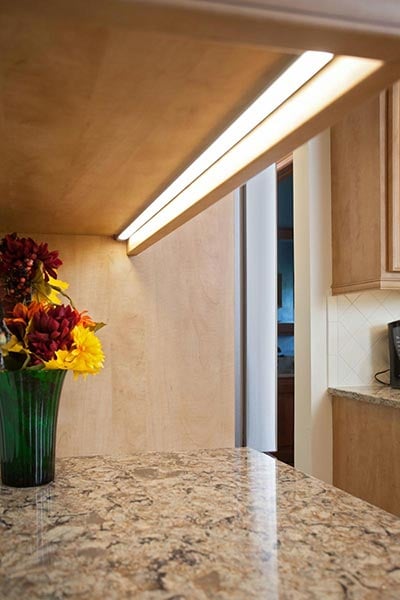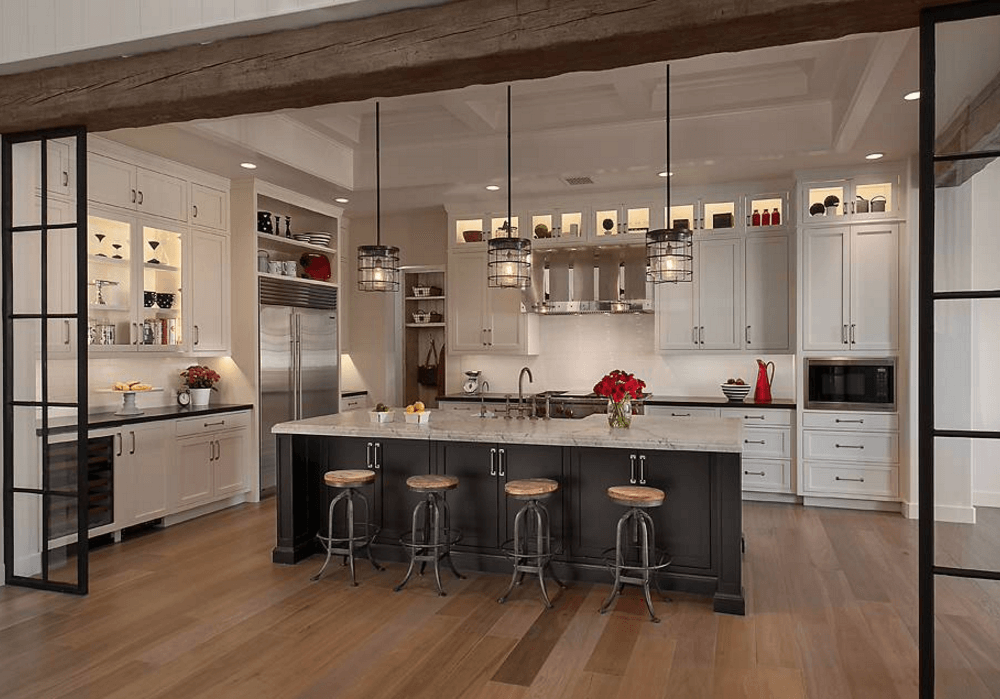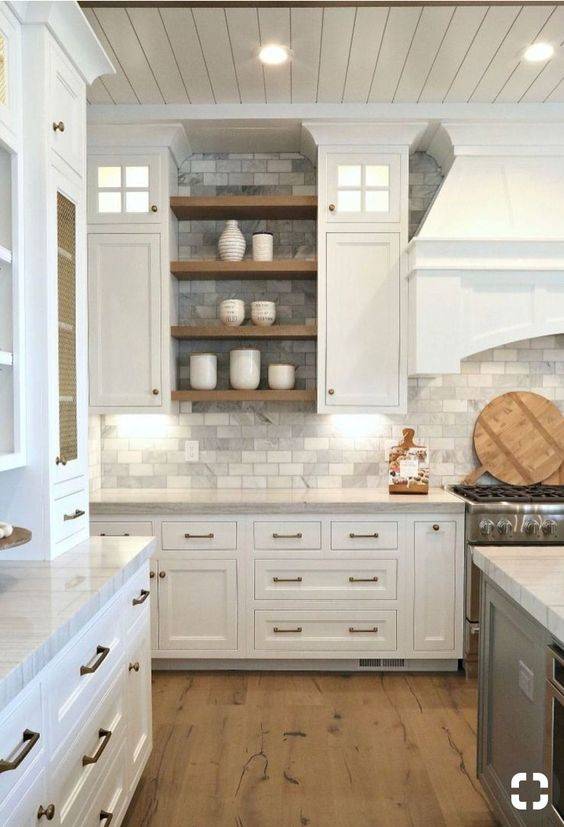Kitchen cupboard lighting is an often overlooked yet crucial aspect of modern kitchen design. Proper lighting can transform a kitchen from a basic, functional space into a warm, inviting environment that enhances the overall aesthetic and makes cooking, cleaning, and organizing much easier. Kitchen cupboard lighting specifically targets areas under cabinets or inside cupboards, where shadows can make it difficult to see what you’re doing. By strategically placing lights in these areas, you not only illuminate your workspace but also add a layer of depth and dimension to your kitchen. There are several types of kitchen cupboard lighting to consider, including LED strips, puck lights, and in-cabinet lighting, each offering its own set of benefits depending on your needs.
One of the most popular types of kitchen cupboard lighting is LED strip lights. These are thin, flexible strips that can be easily adhered to the underside of cabinets or inside cupboards. LED strip lights are energy-efficient, long-lasting, and available in a variety of colors and brightness levels. They provide a continuous line of light that can be customized to fit any length or shape, making them ideal for illuminating countertops or showcasing items inside glass-fronted cabinets. Because they are low-profile, LED strips can be hidden from view, creating a sleek, modern look while providing ample light where it’s needed most.

Puck lights are another common option for kitchen cupboard lighting. These small, round fixtures can be installed under cabinets or inside cupboards, offering targeted, focused light. Puck lights are often used in areas where more concentrated light is needed, such as over a chopping board or inside a pantry. They can be surface-mounted or recessed into the cabinet for a more discreet appearance. Puck lights come in both hardwired and battery-operated versions, allowing for installation flexibility. Additionally, many puck lights are dimmable, providing control over the light intensity to suit different tasks or moods.
In-cabinet lighting is an excellent choice for those who want to highlight the contents of their cupboards or pantry. This type of lighting is installed inside the cupboard, either at the top or along the sides, to illuminate the interior space. In-cabinet lighting is particularly useful in dark or deep cabinets where it can be difficult to see items stored at the back. It’s also a great way to showcase decorative dishware or glassware, adding a touch of elegance to your kitchen. LED strip lights, puck lights, or small spotlights can be used for in-cabinet lighting, depending on the desired effect.

Another benefit of kitchen cupboard lighting is the way it enhances safety in the kitchen. Adequate lighting is essential when working with sharp knives, hot stoves, and other potentially dangerous kitchen tools. By illuminating workspaces and storage areas, kitchen cupboard lighting helps prevent accidents and makes it easier to see what you’re doing, especially in the early morning or late at night when ambient light might be low. It also reduces the need to rely solely on overhead lighting, which can create harsh shadows that make it difficult to see inside cupboards or drawers.
In addition to improving functionality, kitchen cupboard lighting can significantly boost the overall ambiance of your kitchen. Lighting plays a key role in setting the mood of a room, and the kitchen is no exception. By using warm white LED lights, for example, you can create a cozy, inviting atmosphere that makes the kitchen a pleasant place to cook and socialize. Alternatively, cool white or daylight LED lights can give the kitchen a clean, modern feel, perfect for those who prefer a more contemporary look. Some lighting systems even offer the option to change colors or dim the lights, allowing you to adjust the ambiance to suit different occasions.

One of the most appealing aspects of kitchen cupboard lighting is its ability to enhance the visual appeal of the kitchen. By illuminating key areas, such as countertops, backsplashes, and the interiors of glass-fronted cabinets, you can highlight the design elements of your kitchen and make it feel more spacious and luxurious. For example, under-cabinet lighting can draw attention to a beautiful backsplash or high-end countertops, while in-cabinet lighting can showcase your favorite dishware or collectibles. This added layer of lighting can make a significant difference in the overall look and feel of your kitchen, making it a more enjoyable space to spend time in.
When it comes to installation, kitchen cupboard lighting is relatively easy to install, especially with the advent of plug-and-play options and battery-operated lights. Many LED strip lights and puck lights come with adhesive backing, allowing for a quick and easy installation process. For those who prefer a more permanent solution, hardwired options are available, though they may require professional installation. In-cabinet lighting might require more planning, especially if you want the lights to be hidden or recessed, but the result is well worth the effort. Overall, the installation process is straightforward, and the benefits of added lighting in the kitchen are immediate.
Another advantage of kitchen cupboard lighting is its energy efficiency. LED lights, which are commonly used in kitchen cupboard lighting, are much more energy-efficient than traditional incandescent bulbs. They use less power and have a much longer lifespan, which means you’ll save money on both energy bills and replacement bulbs. Additionally, many LED lights are dimmable, allowing you to adjust the brightness level and further reduce energy consumption when full lighting is not needed. With environmental concerns becoming increasingly important, choosing energy-efficient lighting is a smart choice that benefits both your wallet and the planet.

The versatility of kitchen cupboard lighting makes it suitable for kitchens of all sizes and styles. Whether you have a small, compact kitchen or a large, open-concept space, there is a lighting solution that can enhance both the functionality and aesthetic of your kitchen. For small kitchens, under-cabinet lighting can make the space feel larger and more open by eliminating shadows and providing even illumination across the countertops. In larger kitchens, multiple layers of lighting, including under-cabinet and in-cabinet lights, can create a more dynamic and visually interesting environment.
Customizability is another key feature of kitchen cupboard lighting. With so many options available, from color temperature to light intensity, you can tailor your lighting to match your specific needs and preferences. For example, if you do a lot of detailed work in the kitchen, such as baking or meal prep, you might prefer brighter, cooler lighting that mimics daylight. On the other hand, if your kitchen serves as a gathering place for family and friends, you might opt for warmer, softer lighting that creates a more relaxed and welcoming atmosphere. The ability to customize your lighting allows you to create a kitchen environment that is perfectly suited to your lifestyle.
In recent years, smart lighting technology has made its way into the kitchen, offering even more control and convenience when it comes to kitchen cupboard lighting. Smart lights can be controlled via a smartphone app, allowing you to adjust the brightness, color, and timing of your lights from anywhere. Some systems are compatible with voice assistants, such as Amazon Alexa or Google Assistant, enabling hands-free control of your kitchen lighting. Smart lighting also offers the ability to create lighting schedules, so your cupboard lights automatically turn on and off at specific times, adding an extra layer of convenience and energy efficiency to your kitchen.

One often overlooked aspect of kitchen cupboard lighting is its role in home resale value. A well-lit kitchen is a major selling point for potential buyers, and the addition of under-cabinet and in-cabinet lighting can make your kitchen stand out in a competitive market. These lighting features not only enhance the functionality and appearance of the kitchen but also demonstrate attention to detail and a commitment to quality. Investing in kitchen cupboard lighting can be a relatively small upgrade that yields significant returns when it comes time to sell your home.
While kitchen cupboard lighting offers numerous benefits, it’s important to choose the right lighting system for your needs. Consider factors such as the layout of your kitchen, the types of tasks you perform, and your aesthetic preferences. For example, if you have a lot of glass-fronted cabinets, you might prioritize in-cabinet lighting to showcase your dishware. If you frequently cook or bake, under-cabinet lighting with a higher brightness level might be more important. Take the time to evaluate your needs and explore the different options available to ensure you choose the right lighting solution for your kitchen.
Finally, one of the best things about kitchen cupboard lighting is the way it can be used to create a cohesive design throughout the kitchen. By carefully selecting lighting that complements your countertops, backsplash, and overall color scheme, you can create a unified look that ties the entire space together. For example, warm white LED strip lights can enhance the warmth of wood cabinetry, while cool white lights can highlight sleek, modern surfaces like stainless steel or glass. The right lighting can bring out the best features of your kitchen and make it a more enjoyable space to cook, eat, and entertain.


Common Mistakes to Avoid:
One common mistake when installing kitchen cupboard lighting is not planning the placement carefully. Without proper planning, lights can be installed in areas that create glare or shadows, defeating the purpose of having them. Another mistake is choosing lights that are too bright or too dim. It’s important to select the right brightness level for the tasks you’ll be performing in the kitchen.
Failing to consider the color temperature of the lights is another error; warmer lights are generally more flattering and cozy, while cooler lights are better for tasks that require attention to detail. Not taking energy efficiency into account can also be a mistake, as it may lead to higher electricity bills over time. Finally, neglecting to hide the wiring can result in a cluttered, unfinished look that detracts from the overall design of the kitchen.

What types of lights are best for under-cabinet lighting in the kitchen?
LED strip lights are one of the best options for under-cabinet lighting because they are energy-efficient, long-lasting, and provide even illumination. Puck lights are another popular choice, offering focused, targeted light for specific areas. Both options can be dimmable and come in various color temperatures to match your kitchen’s ambiance.
How do I choose the right brightness for my kitchen cupboard lighting?
The right brightness level depends on the tasks you perform in the kitchen and your personal preferences. For general use, a brightness level of around 200-400 lumens per foot is typically sufficient. For task lighting, such as food prep areas, you might want brighter lights around 500-700 lumens per foot. Dimmable lights offer flexibility, allowing you to adjust the brightness as needed.
Is it necessary to hire a professional to install kitchen cupboard lighting?
While some types of kitchen cupboard lighting, such as plug-and-play LED strips or battery-operated puck lights, can be easily installed by a homeowner, more complex installations, like hardwired lights or recessed in-cabinet lighting, may require professional installation. Hiring a professional ensures that the wiring is done safely and that the lights are installed correctly.
Can I add kitchen cupboard lighting to an existing kitchen?
Yes, kitchen cupboard lighting can be added to an existing kitchen. LED strip lights and puck lights are relatively easy to retrofit, even in kitchens that weren’t originally designed with lighting in mind. Battery-operated or plug-in options make it simple to add lighting without the need for major electrical work.
How can I hide the wires from my kitchen cupboard lighting?
Hiding the wires is crucial for a clean, professional look. One way to hide wires is by using cable management systems, such as wire raceways or cord covers, which can be mounted along the underside of cabinets. Another option is to use adhesive clips to tuck the wires neatly out of sight. For a more permanent solution, wires can be routed through the walls or cabinets by a professional electrician.
What color temperature should I choose for my kitchen cupboard lighting?
The color temperature you choose will depend on the mood you want to create in your kitchen. Warm white lights (2700K-3000K) create a cozy, inviting atmosphere, making them ideal for residential kitchens. Cool white lights (4000K-5000K) provide a brighter, more clinical light that is good for task-oriented areas. Daylight white (5000K-6500K) offers the brightest light and is best for areas where precise color representation is important, such as in food prep zones.

Related Posts:
- Kitchen Backsplash Ideas For Light Maple Cabinets
- What Type Of Recessed Lighting For Kitchen
- Kitchen Dining Light Fixtures
- Discount Pendant Lighting Kitchen
- Kitchen Light Temperature
- Kitchen Kick Plate Lighting
- Antique Kitchen Lighting Ideas
- Kitchen Halogen Lights Not Working
- Kitchen Light Cover Panels
- Small Kitchen Recessed Lighting